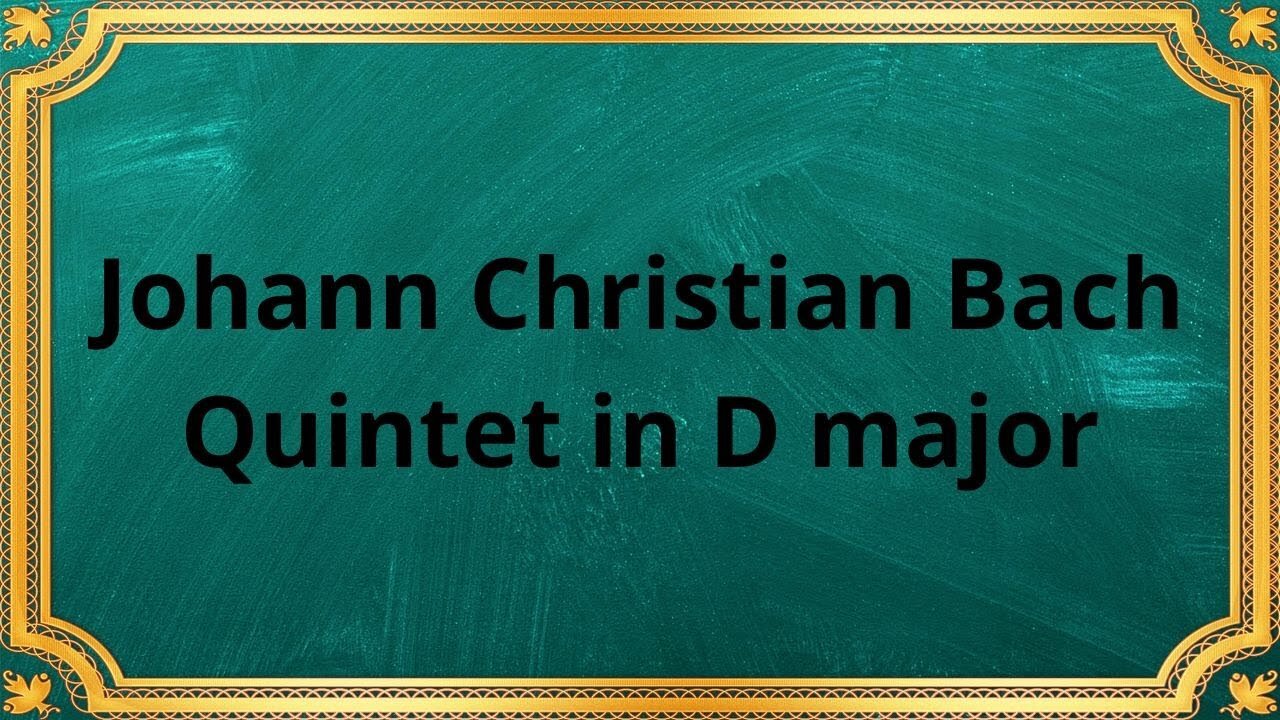Premium Only Content

Johann Christian Bach Quintet in D major
#JohannChristianBach #Quintet #DMajor #ClassicalMusic #MusicalComposition #ChamberMusic #MusicEnsemble #MusicPerformance #InstrumentalMusic #MusicAppreciation #ClassicalComposers #MusicianLife #MusicEducation #MusicCulture #MusicAppreciation #MusicLovers #MusicHistory #ChamberEnsemble #MusicReview
JEAN-PIERRE RAMPAL, flute
PIERRE PIERLOT, Oboe
ROBERT GENDRE, Violin
PAUL HONGNE, Bassoon
ROBERT VEYRON-LACROIX, Harpsichord
Classical music has been a source of enchantment and inspiration for centuries, with composers leaving behind a treasure trove of timeless masterpieces. Among these musical gems, Johann Christian Bach's Quintet in D Major stands out as a testament to his musical genius.
Johann Christian Bach, also known as the "London Bach," was a prominent figure in the classical music era. He composed the Quintet in D Major during his time in London, where he was greatly influenced by the emerging classical style. Bach's quintet, written for flute, oboe, violin, viola, and basso continuo, showcases his ability to blend elements of the Baroque and Classical periods, creating a harmonious and captivating musical experience.
Bach's Quintet in D Major is structured in three movements: Allegro, Andante, and Rondo. The opening Allegro movement immediately captures the listener's attention with its lively and spirited melody. The interplay between the flute, oboe, and strings creates a vibrant and dynamic atmosphere, showcasing Bach's ability to create intricate harmonies and melodic dialogues.
The Andante movement offers a contrasting mood, with its lyrical and introspective melodies. Here, Bach showcases his gift for crafting beautiful and emotionally evocative music. The Rondo movement brings a sense of joy and playfulness, with its lively and rhythmic themes that invite the listener to embrace the music's infectious energy.
Bach's Quintet in D Major evokes a range of emotions, reflecting the composer's ability to convey depth and expression through his music. The Allegro movement fills the air with a sense of excitement and anticipation, captivating the listener from the very beginning. The Andante movement, in contrast, tugs at the heartstrings with its tender and melancholic melodies, evoking a sense of introspection and contemplation. The Rondo movement uplifts the spirit, offering a delightful and playful dance-like quality.
Bach's compositional techniques, including his use of harmonies, dynamics, and expressive markings, allow performers to convey the nuances and emotions of the composition. The interplay between the different instruments creates a captivating dialogue, showcasing the virtuosity and synergy of the ensemble.
Johann Christian Bach's Quintet in D Major remains a cherished piece in the classical music repertoire. Its timeless beauty and expressive qualities continue to captivate audiences and inspire musicians worldwide. The composition stands as a testament to Bach's ability to create music that transcends time, leaving a lasting impact on both performers and listeners.
Conclusion:
Johann Christian Bach's Quintet in D Major is a musical masterpiece that showcases the composer's brilliance and ability to create captivating and emotionally evocative music. Through its three movements, it takes the listener on a journey of emotions, from excitement to introspection and playfulness. This quintet serves as a testament to the enduring power of classical music, leaving an indelible mark on the hearts and minds of its listeners.
You have the opportunity to support the channel:
https://destream.net/live/RadSiarAl/donate
https://www.buymeacoffee.com/6355radsiaral
-
 1:29:47
1:29:47
Real Coffee With Scott Adams
4 hours agoEpisode 2669 CWSA 11/24/24
23.8K20 -
 13:52
13:52
Hershberger's Kitchen
15 hours agoTwo Delicious Dip and Spread Recipes to Try, Inspirational Thought
15K1 -
 3:41:05
3:41:05
Sacred Sage
6 hours ago $1.13 earnedDaz3D: Attempting to Finish Zoe Conversation!
13.3K -
![[Stream #19 ] Gaming, Chatting, you know the drill!](https://1a-1791.com/video/s8/1/9/o/E/e/9oEeu.0kob-small-Stream-Sour-Pickle-100-Foll.jpg) LIVE
LIVE
OneRandomDolly
4 hours ago[Stream #19 ] Gaming, Chatting, you know the drill!
422 watching -
 11:07
11:07
TimcastIRL
1 day agoElon Musk Suggests He’ll BUY MSNBC, Joe Rogan Will REPLACE Rachel Maddow
60.1K50 -
 34:24
34:24
The Rubin Report
22 hours agoFormer CEO: The Aftermath of Vice Media & What's Next for Mainstream Media | Shane Smith
75.9K31 -
 9:14:23
9:14:23
tacetmort3m
1 day ago🔴 LIVE - BECOMING THE UNTOUCHABLE (RADIATION WHO?) - STALKER 2 - PART 3
28.9K4 -
 16:05
16:05
China Uncensored
17 hours agoAnother Car-Ramming Strikes Outside a Chinese School!
21.2K12 -
 9:26
9:26
Dr. Nick Zyrowski
9 hours agoAnti Inflammatory Foods | You MUST Eat These!
15.8K5 -
 15:40
15:40
Bearing
4 hours agoEnd Stage Trump Derangement | Rosie O'Donnell is NOT Doing Well 😬
17.4K75